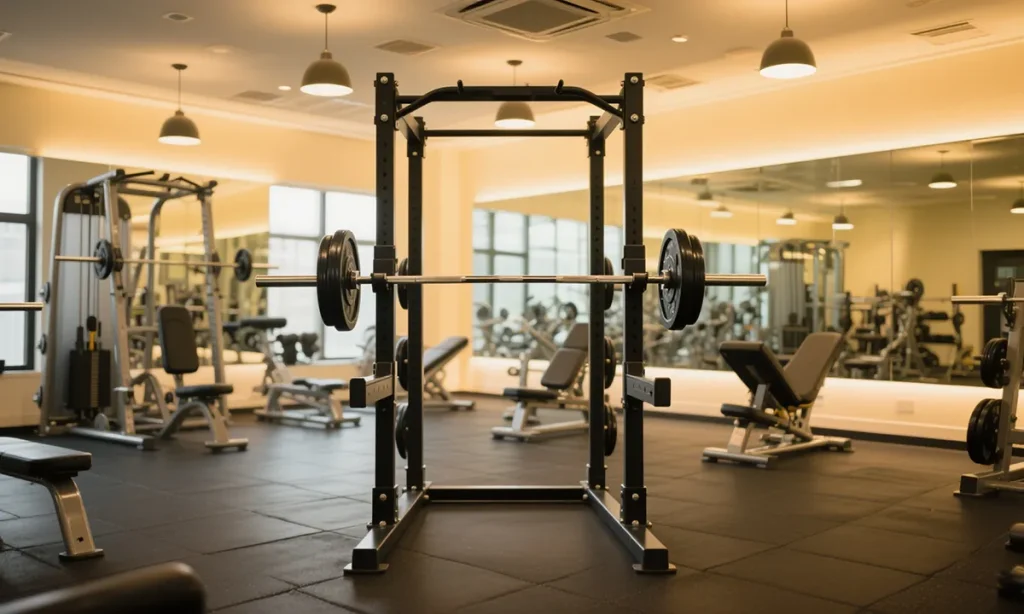Cuando se trata de levantar peso con una barra, especialmente en ejercicios como sentadillas, press de banca o press por encima de la cabeza, se necesita algo que sujete la barra. Ahí es donde estanterías para sentadillas y bastidores eléctricos (o jaulas). Aunque ambos sirven para el propósito básico de sostener la barra, tienen algunas diferencias clave, principalmente en lo que respecta a la seguridad y a los ejercicios que se pueden realizar.
Veamos cada una de ellas.

Comprender la estantería para sentadillas: diseño y función
Piense en un soporte para sentadillas como una estructura más abierta para sujetar la barra. Normalmente tiene dos postes verticales resistentes (como columnas altas) que están conectados, normalmente por una base y, a veces, una barra de dominadas en la parte superior.
- Objetivo principal: Su función principal es sujetar la barra a diferentes alturas mediante unos ganchos ajustables llamados "J-cups". Esto te permite ponerte debajo de la barra con seguridad para hacer sentadillas o colocar la barra para hacer press de banca si tienes un banco.
- Seguridad: Muchos soportes para sentadillas tienen "brazos de seguridad" cortos que sobresalen de los postes delanteros. Están diseñados para coger la barra si no puedes completar un levantamiento, pero como son más cortos y abiertos, puede que no ofrezcan tanta seguridad, especialmente si fallas un levantamiento hacia delante o hacia atrás. Para levantamientos más pesados en un rack de sentadillas, se recomienda encarecidamente tener un observador - alguien que te ayude a levantar el peso si te quedas atascado.
- Estructura: Está abierta por los lados y por detrás.
Así pues, un soporte para sentadillas es estupendo para apoyar la barra en los levantamientos principales, pero sus características de seguridad son menos completas que las de una jaula.
Comprender la jaula de potencia: Centrarse en la seguridad
Un rack de potencia, a menudo llamado simplemente "jaula", es una estructura más cerrada. Es como una gran caja o jaula rectangular formada por cuatro o incluso seis postes verticales unidos por barras horizontales.
- Objetivo principal: Al igual que un soporte para sentadillas, sujeta la barra con J-cups para sentadillas, presses, etc. Pero su mayor característica es la seguridad.
- Seguridad: Aquí es donde la jaula realmente destaca. Tiene barras de seguridad largas y resistentes (a veces llamadas pasadores o correas) que puedes ajustar a cualquier altura que necesites en la jaula. Si estás haciendo una sentadilla o un press de banca pesado y no puedes levantar el peso, puedes simplemente dejar que la barra caiga sobre estas barras de seguridad. Esto significa que puedes acercarte a tu límite incluso cuando entrenas solo, con un riesgo mucho menor de que el peso caiga sobre ti.
- Estructura: Forma un espacio contenido o "jaula".
Un rack de potencia o una jaula proporcionan un entorno mucho más seguro para levantar pesos pesados, especialmente cuando no tienes un observador humano.
Rack de sentadillas vs. Jaula: diferencias clave comparadas
He aquí una sencilla comparación entre los soportes para sentadillas y las jaulas (power racks) para destacar las principales diferencias:
| Característica | Rack de sentadillas | Jaula (Power Rack) |
|---|---|---|
| Estructura | Más Abierto (normalmente 2 puestos principales) | Caja o jaula cerrada (normalmente de 4 ó 6 postes) |
| Seguridad primaria | J-cups, a menudo brazos cortos de seguridad | J-cups, barras/pernos de seguridad largos y ajustables en |
| Nivel de seguridad | Menos seguridad para levantar cargas pesadas en solitario; a menudo se necesita un observador | Mucha más seguridad para levantar cargas pesadas en solitario; atrapa la barra en el interior |
| Ejercicios | Principalmente Sentadillas, Press de banca (con banco), Press de cabeza | Amplia gama de ejercicios realizados en la jaula (sentadillas, banco, press, press de barra, jalones en rack), además de dominadas (a menudo integradas) |
| Espacio | Generalmente ocupa menos espacio (menos profundidad) | Ocupa más espacio (más profundidad) |
| Versatilidad | Más limitado al soporte básico del bar | Más versátil gracias a los puntos de fijación y seguridad cerrados |
Elección de la estantería adecuada: ¿Squat Rack o Power Rack?
Decidir entre un rack de sentadillas y un rack de potencia se reduce a lo que más necesites:
- Para una máxima seguridad (especialmente al levantar objetos pesados solo): Un rack o jaula de potencia es la mejor opción. La estructura cerrada y las largas barras de seguridad ofrecen mucha más protección.
- Para ahorrar espacio: Un soporte para sentadillas suele ocupar menos espacio en el suelo, sobre todo en profundidad. Si el espacio es su mayor limitación y se levanta principalmente con un observador o utilizar pesos más ligeros, un estante de la sentadilla podría ser suficiente.
- Para variar el ejercicio: Un rack de potencia a menudo permite una mayor variedad de ejercicios realizados con seguridad dentro de la jaula, como prensas de pin o tirones de rack, y por lo general tienen más opciones para los archivos adjuntos.
Conclusiones: Cómo elegir
En términos sencillos, la principal diferencia entre un rack de sentadillas y un rack de potencia (jaula) radica en su estructura y en el nivel de seguridad que proporcionan. Un rack de sentadillas es más abierto y se utiliza mejor con un observador para los levantamientos pesados, mientras que el diseño cerrado de un rack de potencia y las barras de seguridad completas ofrecen un entorno más seguro para el entrenamiento pesado en solitario y una gama más amplia de ejercicios. Tenga en cuenta sus necesidades de seguridad, el espacio disponible y los objetivos de entrenamiento a la hora de elegir el soporte adecuado para su gimnasio.
